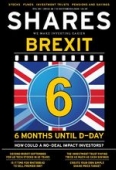Archived article
Please note that tax, investment, pension and ISA rules can change and the information and any views contained in this article may now be inaccurate.
Why September is an important month for Japan (if not the world)

September is going to be an important month for those investors who have exposure to Japan.
First, the Bank of Japan (BoJ) is scheduled to provide its latest monetary policy decision on 19 September. Although Governor Haruhiko Kuroda is publicly still pressing ahead with qualitative and quantitative easing (QQE), the BoJ is undershooting its bond-buying targets and finding it an increasing struggle to bend the market for Japanese government bonds to its will.
Second, Prime Minister Shinzō Abe must fight a triennial contest for the leadership of the ruling Liberal Democratic Party (LDP) on or before 20 September. A loss could see his position as PM become untenable and the so-called ‘Three Arrows,’ or ‘Abenomics’ programme come under threat, to the potential consternation of those who have warmed to Japanese equities because of his targeted reforms.
LEADERSHIP FIGHT
Nothing can be taken for granted in Japanese politics (or so it seems anywhere else these days) but Prime Minister Abe is expected to prevail in the LDP leadership poll, barring some grievous self-inflicted wound.
The opposition on paper does not look strong, not least because leading malcontents defected to the short-lived Tomin First party of Yuriko Koike, only for it to implode immediately after her crushing defeat in the 2017 General Election.
At the time of writing his only confirmed opponent is former Defence Minister Shigeru Ishiba. Abe saw him off to win the LDP leadership in 2012 so he does not look overly threatening especially as former Foreign Minister Fumio Kishida’s decision to support the PM looks to snuff out any room for dissent within the party ranks.
As such, it seems that Abe’s political colleagues like what they see, every bit as much as anyone with portfolio exposure to the Tokyo markets.
The Nikkei 225 index is up by 130% since Abe’s landslide win in 2012 in local currency terms (it is up by 114% in sterling, compared to a 23% gain in the FTSE All-Share over the same period) thanks at least in part to the Three Arrows programme, which comprises:
– Fiscal stimulus
– Economic and social reform, including a shake-up of corporate governance and how companies interact with investors, an area of great improvement but one where there is still scope for further advances in return on equity and dividends in particular
– Huge monetary stimulus – and this is where the Bank of Japan comes in
POLICY POSER
To support Abenomics, help Japan cope with its 250% debt-to-GDP ratio and try to boost both growth and inflation, the BoJ has run ultra-loose monetary policy for two decades and more. But it has been taken to a new level by Governor Haruhiko Kuroda.
Since October 2014, the BoJ has been buying ¥80tr a year in Government bonds, real estate investment trusts (J-REITs) and equity exchange-traded funds (ETFs) – that is the equivalent of £550bn a year, more than the Bank of England has done in QE in total since it started with its scheme in 2009.
Yet inflation is still not at the BoJ’s 2% target and the yield on the headline JGB is starting to break out above the central bank’s intended 0.1% cap, in a direct threat to its monetary authority.
The 10-year JGB may be feeling the strain as Japanese GDP starts growing again, after a stumble in the first quarter, but also because there are suggestions that the BoJ is starting to stealthily taper – or cut back on – its QQE scheme, either because it wants to, or because it has to do so.
BoJ assets already represent more than 90% of GDP, compared to 24% of GDP for the Bank of England in the UK and 20% for the Federal Reserve in the US.
Although tapering and now withdrawal of QE by the US Federal Reserve has not knocked the US stock market off its path, one reason may have been the BoJ (and European Central Bank) stepped up and poured on policy stimulus just as the Americans stopped.
But even a modest withdrawal of QE and liquidity by the US has caused chaos in emerging markets, where currencies such as the Argentine peso, Indian rupee and Russian rouble have all cratered.
If Japan starts to taper QE then another source of cheap cash will start to dry up, especially as the ECB plans to stop adding to its QE programme in December. That could have wider implications than we realise, looking at this final chart, which shows how growth in the assets of the world’s five leading QE proponents may have helped to goose global share prices.
So while the BoJ is not expected to make any dramatic changes this month, investors may need to check any subtle changes in Governor Kuroda’s scripts, whether they have direct exposure to Japan or not.
Russ Mould, investment director, AJ Bell
Important information:
These articles are provided by Shares magazine which is published by AJ Bell Media, a part of AJ Bell. Shares is not written by AJ Bell.
Shares is provided for your general information and use and is not a personal recommendation to invest. It is not intended to be relied upon by you in making or not making any investment decisions. The investments referred to in these articles will not be suitable for all investors. If in doubt please seek appropriate independent financial advice.
Investors acting on the information in these articles do so at their own risk and AJ Bell Media and its staff do not accept liability for losses suffered by investors as a result of their investment decisions.
Issue contents
Big News
- Investors braced for potential dilutive equity fundraise from Sirius Minerals
- Will Unilever exit the FTSE 100?
- Second worst September start for US tech stocks in 10 years
- Are UK markets finally ready to shed their Brexit discount?
- Share price decline implies Debenhams is at death’s door
- Is this the beginning of the end for Whitbread?

 magazine
magazine











